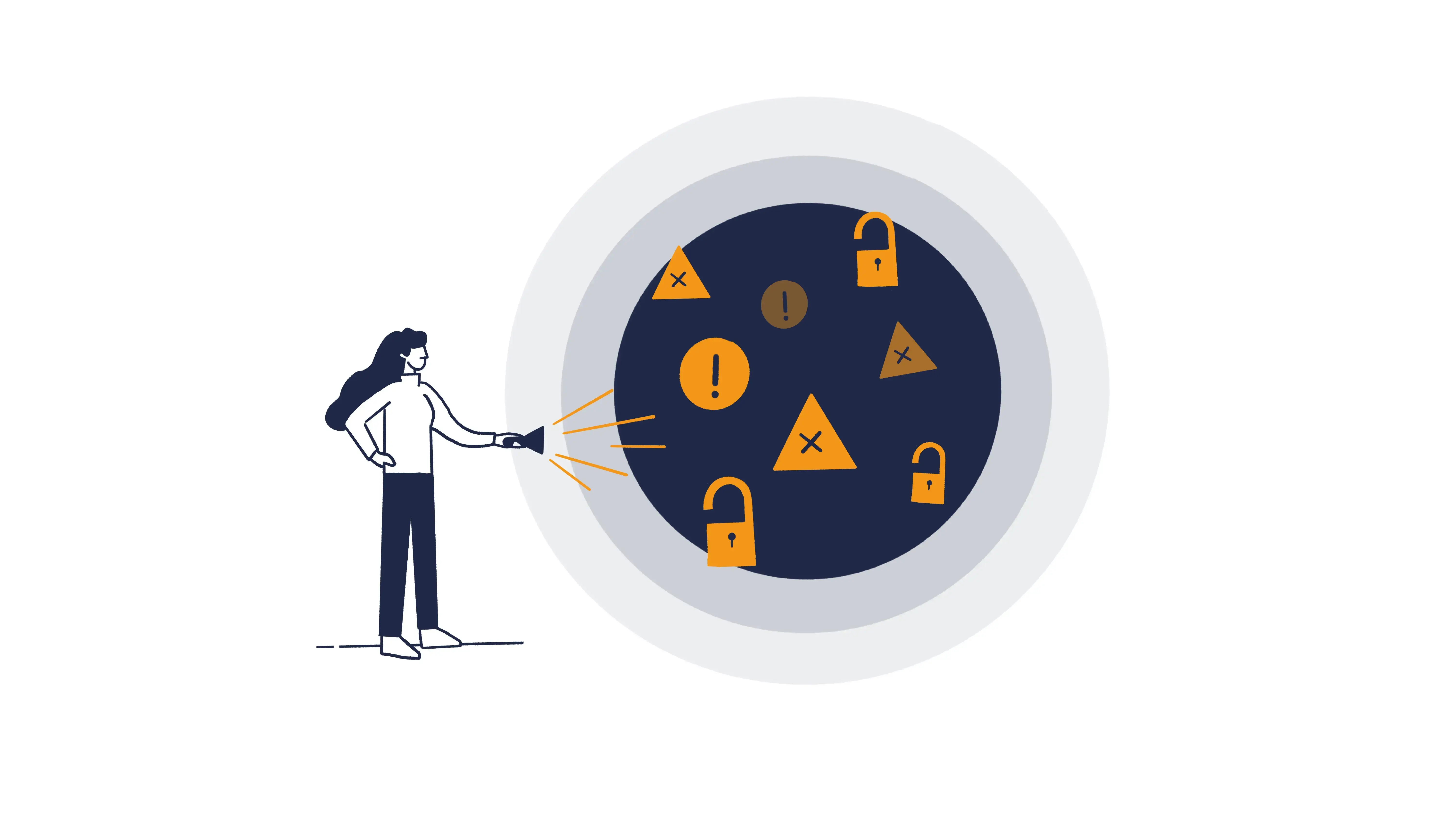APTs, or Advanced Persistent Threats, are highly sophisticated, long-term cyberattacks aimed at stealing sensitive data from targeted organisations. Unlike ordinary cyberattacks, APTs can go undetected for months or even years.
This article will detail what APTs are, how they operate, and strategies to protect against them. Implementing comprehensive APT security measures is crucial for guarding against these threats, requiring a multi-faceted approach that includes collaboration between administrators, users, and security providers.
Key facts about ATPs
- Advanced Persistent Threats (APTs) are sophisticated, long-term cyber intrusions aimed at stealing sensitive data, characterised by stealth and meticulous planning.
- The lifecycle of an APT attack includes stages such as reconnaissance, initial access, establishing a foothold, lateral movement, and data exfiltration, each demanding specific techniques and strategies.
- Effective defence against APTs requires a multi-layered security approach, including traffic monitoring, strict access controls, regular software patching, and fostering a strong security culture.
- Monitoring database operations is crucial, as a significant increase in database operations can signal suspicious activity, helping to detect potential breaches and secure sensitive information.
What are Advanced Persistent Threats (APTs)?
Advanced Persistent Threats (APTs) are a breed apart from typical cyberattacks. These undetected cyber intrusions are meticulously designed to steal sensitive data over extended periods, often remaining hidden within networks for months or even years. Unlike ordinary hacking methods, advanced persistent threats employ sophisticated techniques that require substantial resources and expertise, making them a formidable challenge to detect and counter.
The hallmark of APTs is their long-term infiltration strategy. APT attackers are usually well-funded and experienced teams of cybercriminals who strategically target high-value organisations, such as large enterprises and government agencies. Their primary objectives encompass espionage, financial crime, and sabotage, with attackers often zeroing in on sensitive infrastructures like power grids and government databases to exfiltrate valuable data. A successful APT attack can last for extended periods, accumulating extensive data before detection and exfiltration, demonstrating the patience and precision of these threat actors.
What makes APTs particularly dangerous is their ability to remain undetected within a network. This stealthiness allows attackers to gather critical business information, intellectual property, and sensitive data without raising alarms. The sophisticated nature of APTs highlights the need for robust, multi-layered security measures, requiring collaboration between administrators, users, and security providers.
What are APT attacks known for?
Advanced Persistent Threat (APT) attacks are distinguished by their high level of sophistication, persistence, and targeted approach. Unlike typical cyberattacks, APT attacks are meticulously planned and executed over extended periods, often involving custom-made malware and exploits specifically designed to gain access to a target network. These attacks are not random; they are carefully directed at high-value organisations such as government agencies, financial institutions, and large corporations.
One of the primary objectives of APT attacks is the theft of sensitive data, including intellectual property, financial information, and personal data. The attackers employ advanced evasion techniques and stealthy malware to remain undetected within the network for as long as possible, making these attacks particularly challenging to detect. The consequences of APT attacks can be severe, leading to significant financial loss, reputational damage, and even compromised national security.
APT attacks often begin with social engineering tactics, such as spear phishing and whaling, to gain initial access to the target network. These tactics involve sending highly targeted and convincing emails to specific individuals, tricking them into revealing their login credentials or executing malicious software. Once inside, the attackers establish a foothold and begin their long-term infiltration.
The actors behind APT attacks can vary, including nation-state actors, cybercriminal groups, and other malicious entities. These attackers often operate as part of specialised APT groups, which are teams of hackers and malware developers with the expertise and resources to carry out complex operations. To defend against APT attacks, organisations must implement advanced security measures, including threat intelligence, incident response planning, and security awareness training.
What is the lifecycle of an APT attack?
An APT attack typically begins with reconnaissance, where attackers gather information about their target. This is followed by the initial compromise, where they gain access to the network. Once inside, they establish persistence, escalate privileges, and move laterally across the network to expand access. Monitoring database operations for significant increases can be crucial in detecting suspicious activity during these stages.
The final stages involve data acquisition and exfiltration, where sensitive data is collected and transferred out of the network. Throughout this process, APT attackers employ sophisticated techniques to maintain access and avoid detection. Let’s delve deeper into each of these stages to understand how APTs operate.
What are the initial access techniques?
The initial access phase is critical for APT attackers as it sets the stage for the entire operation. Advanced persistent threats often gain initial access through a variety of techniques, including spear phishing and exploiting software vulnerabilities. Spear-phishing tactics are particularly effective, targeting high-profile individuals within an organisation. These tactics involve sending carefully crafted emails that appear legitimate but contain malicious links or attachments designed to trick recipients into providing their login credentials or executing malicious software.
Exploiting software vulnerabilities is another common method used by APT groups. For instance, APT28 has been known to exploit flaws in the Windows Print Spooler. Volt Typhoon, another notorious APT group, focuses on exploiting zero-day vulnerabilities in critical infrastructure, enhancing their long-term access strategies.
These techniques highlight the importance of maintaining robust cybersecurity practices and staying vigilant against potential threats.
How do APT attackers establish a foothold?
Once initial access is gained, APT attackers move to establish a foothold within the network. This involves leaving backdoors open for future access, ensuring they can return even if the initial entry point is discovered and closed. Cybercriminals frequently use backdoors and tunnels created via malware or code rewriting to maintain access.
A crucial aspect of maintaining access is the connection to an external command and control server. This allows attackers to manage the hacked systems remotely and install additional backdoors or create user accounts to ensure continued access to compromised systems. Understanding the workings and vulnerabilities of a compromised system is essential for attackers to maintain their foothold and continue gaining access to their activities undetected.
How do attackers expand their access?
After establishing a foothold, APT attackers focus on expanding their access within the network. This stage, known as lateral movement, involves exploiting existing vulnerabilities to navigate through the network and compromise additional systems. Hackers may use password cracking techniques to gain administrative rights, allowing them to access other servers and secure parts of the network.
To broaden their presence, attackers compromise key staff and gather sensitive data. Various tools such as worms, keyloggers, and spyware are utilised to conceal their activities and ensure ongoing access. This widespread presence within the network allows APT attackers to collect valuable information over an extended period without detection.
How do attackers exfiltrate data?
The final stages of an APT attack involve data acquisition and exfiltration. APT attackers typically store stolen information in a secure location within the network until they collect enough data. To distract security personnel during data exfiltration, attackers may deploy denial-of-service (DoS) attacks, creating a smokescreen for their main operation.
Once the security team is distracted, the attackers transfer the stolen data to external servers. Even after data exfiltration, the compromised network remains vulnerable, allowing attackers to revisit and exploit it further if necessary. This stage highlights the importance of continuous monitoring and robust security measures to detect and prevent data theft.
What are the typical APT actors and their motives?
Various APT actors are driven by different motives, ranging from financial gain to political objectives. Nation-states, cybercriminals, and groups motivated by financial gain or political agendas are common perpetrators of APT attacks. For instance, the Lazarus Group is notorious for its significant financial cyber-heists, including a major theft from a cryptocurrency exchange in 2024.
Espionage is another primary motive for APT actors. APT31, for instance, has conducted espionage operations against U.S. businesses, leading to charges against individuals involved in 2024. Similarly, APT29 has been involved in espionage campaigns targeting Ukrainian state agencies, utilising phishing techniques to achieve their objectives.
What are the common indicators of APT attacks?
Identifying the presence of an APT within a network can be challenging, but certain indicators can signal an APT attack. Unusual login activities and the presence of backdoor Trojans within the network are common signs of an APT. Strange user account activities, such as unexpected privilege escalations or login attempts from unusual locations, often indicate potential APT involvement. A significant increase in database operations can also signal suspicious activity and potential APT attacks.
Unusual outbound data traffic, for example, can signal that sensitive data is being exfiltrated. Continuous monitoring and analysis of network traffic help in identifying and mitigating APT threats before they can cause significant damage.
What are the most effective security measures against APT?
Detecting and responding to APTs requires a comprehensive and proactive approach to IT security. One of the key strategies is to leverage threat intelligence, which involves gathering and analysing information about potential threats to anticipate and mitigate attacks before they occur. By understanding the threat landscape and the tactics, techniques, and procedures (TTPs) used by APT groups, you can better prepare and defend against potential attacks.
Traffic monitoring and analysis
Focusing on detecting malicious activity within the network, rather than solely preventing infiltration, is crucial. Automatic threat detection and utilising endpoint data for visibility into attacks empower security teams against APTs. Various cybersecurity and intelligence solutions, monitoring network traffic, access control, and regular patching are necessary tactics to protect against APT attacks.
These look for unusual network traffic, suspicious login attempts, and other anomalies that could indicate a breach. Advanced security tools, such as intrusion detection systems and security information and event management (SIEM) systems, can help identify and respond to these threats in real time. Implementing patching and vulnerability management programs is also vital to reduce the risk of exploitation.
Implementing access controls
Two-factor authentication (2FA) adds an extra layer of security to user accounts, making it harder for attackers to gain access. Effective access controls also involve filtering incoming emails to prevent phishing attempts and other social engineering tactics. Enforcing security policies related to user access and authentication helps protect against unauthorized access and potential APT attacks.
Encryption
Protecting sensitive data requires the use of secure communication channels and encryption. Organisations should ensure that all sensitive information is encrypted both in transit and at rest to prevent unauthorised access.
Regular patching and updates
Operating system vulnerabilities and outdated software are common targets for attackers looking to gain access to a network. Strict update policies for applications should be enforced to ensure effective whitelisting and security.
Patching network software and web servers regularly helps maintain the security of the network and reduces the risk of exploitation by APT attackers. Continuous monitoring and proactive patch management are essential components of a robust cybersecurity strategy.
Incident response planning
Incident response planning is another critical component. Organisations should have a clear incident response plan, detailing procedures for containment, eradication, recovery, and post-incident activities. This plan should be regularly updated and tested to ensure its effectiveness in the event of an APT attack.
Collaboration with other organisations and sharing threat intelligence can also enhance your ability to defend against APTs.
What is the role of a security culture in defending against APTs?
When employees are trained to recognise and report suspicious activities, the risk of APT attacks can be significantly reduced. Regular cybersecurity training for employees is crucial in developing the skills needed to identify phishing attempts and other social engineering tactics used by APT actors.
Involving all organisational levels in security initiatives fosters a collective responsibility for cybersecurity. This collective effort enhances the overall defense against APTs, as everyone plays a role in maintaining security. Creating a security-conscious environment helps protect organisations from the persistent threat of APTs.
Summary
Effective defense against APTs requires a multi-layered approach, including traffic monitoring and analysis, implementing strict access controls, and regular patching and updates. Fostering a security culture where employees are vigilant and trained to recognise threats, further strengthens the overall defence. By adopting comprehensive security measures and promoting a proactive security culture, organisations can better protect themselves against the ever-evolving menace of advanced persistent threats.
Frequently Asked Questions
What makes Advanced Persistent Threats (APTs) different from regular cyberattacks?
Advanced Persistent Threats (APTs) differ from regular cyberattacks by engaging in prolonged and undetected infiltration into networks, employing sophisticated techniques and substantial resources to extract sensitive information over extended durations. This makes APTs particularly concerning.
How do APT attackers initially gain access to a network?
APT attackers primarily gain initial access to a network through spear phishing, exploiting software vulnerabilities, and employing social engineering techniques. These methods allow them to circumvent security measures effectively.
What are some common indicators of an APT attack?
Common indicators of an APT attack include unusual login activities, backdoor Trojans, strange user account behaviors, and abnormal outbound data traffic. Identifying these signs early can be crucial for mitigating potential threats.
What are the most effective security measures against APTs?
Network traffic monitoring and analysis, enforcing strict access controls, conducting regular patching and updates, and cultivating a security-conscious culture are the most effective measures against APTs. These practices collectively enhance an organisation’s defense against sophisticated threats.
Who are the typical actors behind APT attacks, and what are their motives?
Typical actors behind APT attacks are nation-states and cybercriminals, whose motives often include espionage, financial gain, and political sabotage. Understanding these actors and their intentions is crucial for effective cybersecurity measures.



